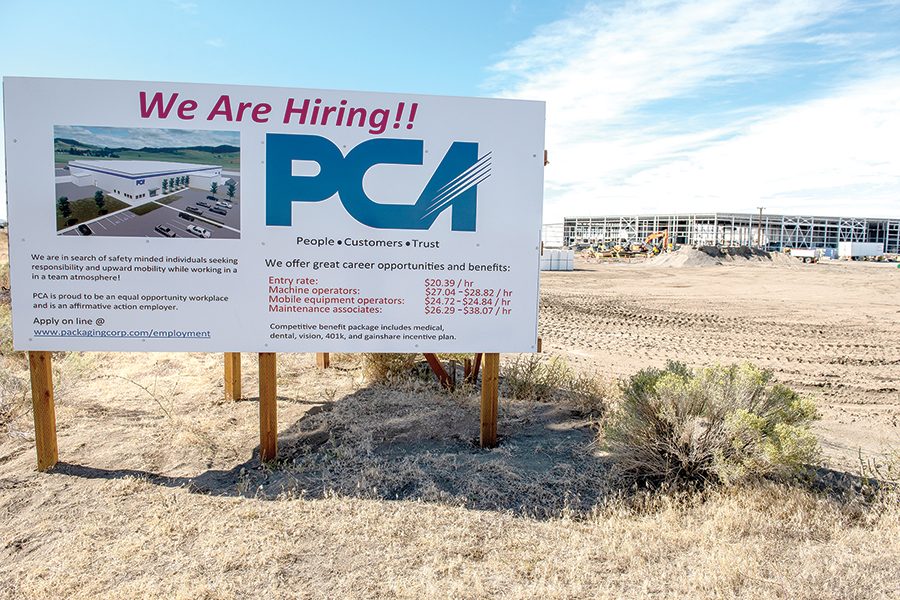
Home » Economic leaders reflect on top accomplishments of 2019
Economic leaders reflect on top accomplishments of 2019

December 16, 2019
Expansions, visions cited as year’s biggest successes
Those focused on
growing, promoting and improving the Tri-City economy are counting up their
2019 successes and looking ahead to plans for the upcoming year and decade.
Recent wins include
plans for an expansion of the Three Rivers Convention Center, a new nonstop
flight from Pasco to Chicago, Richland’s Preferred Freezer Services expansion
and opening of Packaging Corporation of America, and the conclusion of the
second phase of the myTRI 2030 project, which is working to harness a community
vision for the Tri-Cities over the next 10 years.
“We’ve had a good year.
I think it can always be better, but it was a good year,” said Carl Adrian,
executive president and chief executive officer of the Tri-City Development
Council. The year wasn’t without its disappointments, as United Airlines
announced in November it was canceling a highly-marketed nonstop flight to Los
Angeles International Airport.
The head of Visit
Tri-Cities had called the daily flight a “game changer.”
“Even though the flight
is going to go away, we have been planting the seeds that the Tri-Cities is a
wine region, so that doesn’t go away,” said Michael Novakovich, president and
chief executive officer of Visit Tri-Cities. “We’ve still got those wine lovers
and they’re looking for places to go. We’ve heard of some over-tourism in
northern California, so if someone has to turn the spigot off, ‘Welcome to
Washington!’ ”
The community is
building on this strong reputation for winemaking, expecting two new American
Viticultural Areas in the Mid-Columbia to become officially recognized, while
also feeding a growing appetite for science tourism with a future visitor’s
center expected at the Laser Interferometer Gravitational-Wave Observatory,
known as LIGO, at the Hanford site.
“We have these wonderful
assets and we’re working to make them more accessible to all,” Novakovich said.
New businesses continue
to open or expand each year, resulting in dozens of yearly groundbreaking and
ribbon cuttings for the Tri-City Regional Chamber of Commerce, said Lori
Mattson, the chamber’s president and CEO.
“When I look back on
that and see how many ceremonies we participated in, it tells me that the
economy here is strong and entrepreneurs are opening new businesses and there
are multiple locations for current businesses,” she said.
The chamber boasts
1,200 members and has a counselor focused exclusively on helping small
businesses identify and apply for government contracts at the Procurement
Technical Assistance Center.
“(The counselor) meets
with businesses all week long and counsels them, helps them understand the
paperwork, like how do you find a contract or bid on it? Is your organization
even ready for that?” Mattson said.
The PTAC counselor is
an employee of the chamber but also part of a statewide network.
TRIDEC is preparing for
its longtime leader Carl Adrian to retire in early 2020. Focused on growing the
Tri-Cities economy for more than 15 years, Adrian believes the biggest success
from 2019 is the $35 million expansion of Preferred Freezer Services in
Richland, as well as the nearby cardboard-box making facility built by
Packaging Corporation of America.
“Both of those
projects, to some degree, were driven by Lamb Weston’s expansion,” Adrian said.
“They’re both involved in the supply chain for Lamb Weston. When the community
has a win, when TRIDEC has a win, it’s kind of a gift that keeps on giving
because those companies are here for the long haul. They’re going to continue
to pay property taxes every year. They’re going to continue to have multi-million
dollar payrolls every year that create a multiplier effect in the community.”
Preferred Freezer’s
expansion was expected to create 75 additional jobs with another 100 nearby at
PCA.
“A win in any city is a
win for every city,” said Ashley Stubbs, director of communications at TRIDEC.
As more jobs are
created in the community, there are an increasing number of amenities available
to attract both community residents and visitors.
“We’re working to
change the community narrative and getting the community to understand how
amazing the Tri-Cities is, and really flipping this idea that there’s nowhere
to eat and there’s nothing to do,” Novakovich said. “When, in fact, we have
some incredible opportunities here, but you need to get out and explore them,
and then talk about it. There are cool things here.”
Novakovich’s team is
promoting some of the science-related attractions through a campy music video
encouraging viewers with an original song called, “Come On Get Your Geek On.”
It highlights places like the Hanford B Reactor, Reach Museum, Bechtel National
Planetarium, LIGO and the USS Triton Submarine Memorial Park.
Novakovich hopes
tourists and residents alike will be interested in the offerings around the
community, as more than 6,300 people have jobs directly related to tourism in
the Tri-Cities, and visitors pump more than half a billion a year into the
local economy.
“Whether the residents
recognize it or not, we’re all touched by it,” he said.
At the chamber,
Mattson’s team is dreaming big for what the Tri-Cities could offer in 10 years’
time. It first launched myTRI 2030 to the public in 2018, but is gearing up for
a big push as 2019 closes, announcing 60 “big” ideas identified across six major
opportunity areas.
Considered a regional
vision project, myTRI 2030 has assembled experts and practitioners in the “big
buckets” of agriculture, energy, education, inclusion, life and prosperity.
While hosting “big vision” workshops and studying the efforts of other
communities, Mattson still says, “We’re literally pouring the road as we drive
on it. We plan this far ahead and then we execute, and then as we’re executing,
we’re saying, ‘OK, we’re reaching the end of the road, what are we doing now?’
”
The third phase of
myTRI 2030 includes the creation of councils made up of about a dozen people
for each of the focus areas.
“These are people who
are connected, these are people who are influential, these are people who are
visionary, who are collaborative and could look at this list of 10 potential
things and decide which ones we would work on. We’re not going to do 60 things
in 10 years, but we might do a few in each area, or maybe one big one, and it’s
going to take 10 years to accomplish,” she said.
Thanks to financial
support from founding donors that saw them through the first phase, Mattson
said the group will continue to fundraise and work with the community to
execute a shared vision.
“We hope that over the
course of the next 10 years, there could be two or three things every year that
could be actually up and running, and then something else comes up, and then in
10 years we could look back and say, ‘Gosh, look at what the community
accomplished,’ ” she said.
Novakovich recognizes
community support is critical when it comes to building on resources that
already exist and can often take some public convincing to recognize the
overall benefit to the community tax base, contributing to budgets for first
responders and public education. “When you invest in something like an aquatic
center or the convention center or the HAPO Center, while it may look on the
front end like things don’t pencil so well, the economic impact of it, what
happens on the back side of that with taxes and visitor-generated taxes make
great sense and far outweigh any subsidy that’s paid by the cities,” Novakovich
said.
A public-private
partnership is behind an upcoming $85 million project to expand the Three
Rivers Convention Center, adding a hotel, retail building and parking. Novakovich
sees it as a necessity for the Tri-Cities so it doesn’t lose convention
business to Yakima and Spokane.
The future project’s
close proximity to Vista Field is an added benefit due to the planned growth at
the central Kennewick site.
“We are super excited
about Vista Field,” Novakovich said. “People visiting like to be able to get
out and walk around, so to be able to have a walkable district with food and
amenities, it’s exciting.”
Adrian said TRIDEC has
offered assistance to the Port of Kennewick’s Vista Field project to recruit
anchor tenants. “With the infrastructure being put into Vista Field right now,
I think somebody’s going to come look at that and have a little clearer vision
of what that can look like other than just a runway,” he said.
Adrian hopes the person
who replaces him will bring fresh ideas and a forward-looking vision.
He’s proud of the
organization’s federal advocacy that helped make the case for a federal budget
for the region that was $341 million above the president’s original request.
Adrian said the latest
request is about $500 million more than the president’s budget for 2020, and
mirrors the request of the Senate.
A budget is not yet in
place, but the Tri-Cities will continue to outline its successes while
diversifying the economy, attracting new businesses and supporting those in
place.
“We are looking at,
‘How do we leverage all of our experience and legacy in energy and the role
that we’ve played looking ahead to the future and developing and cultivating
new energy sources?’” Stubbs said.
Leveraging that
experience could be part of one of the potential projects kicked off through
myTRI 2030 efforts.
“We say the table’s
going to get bigger and rounder,” Mattson said. “It’s exciting to think in 10
years, how many people can serve on a council or be on a team and work on a
project and how many will have done that in 10 years’ time.”
Local News Year in Review





